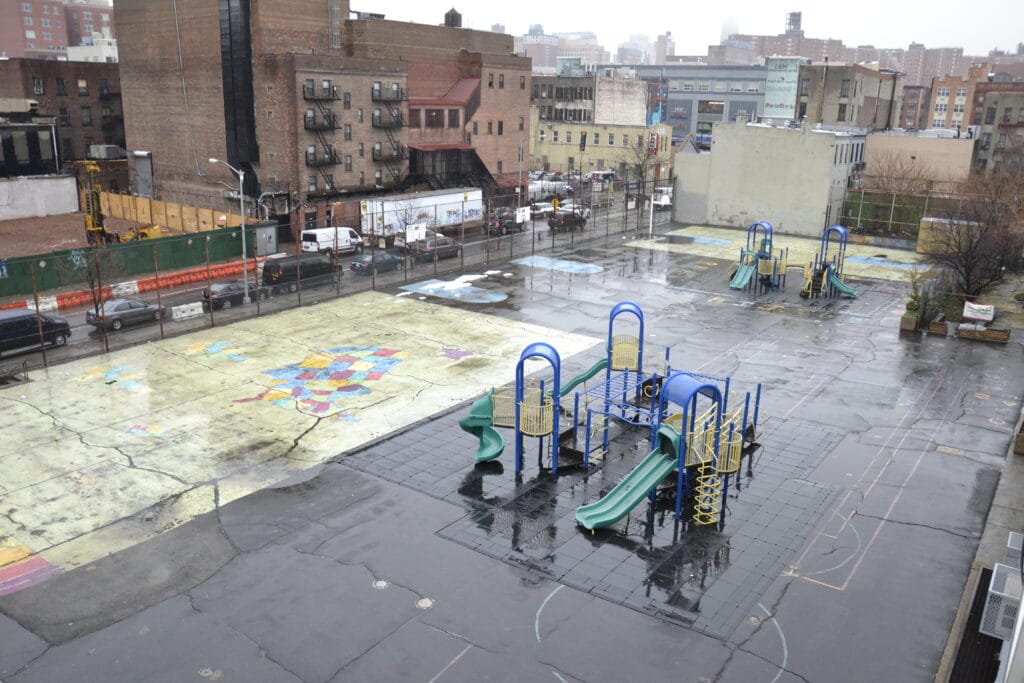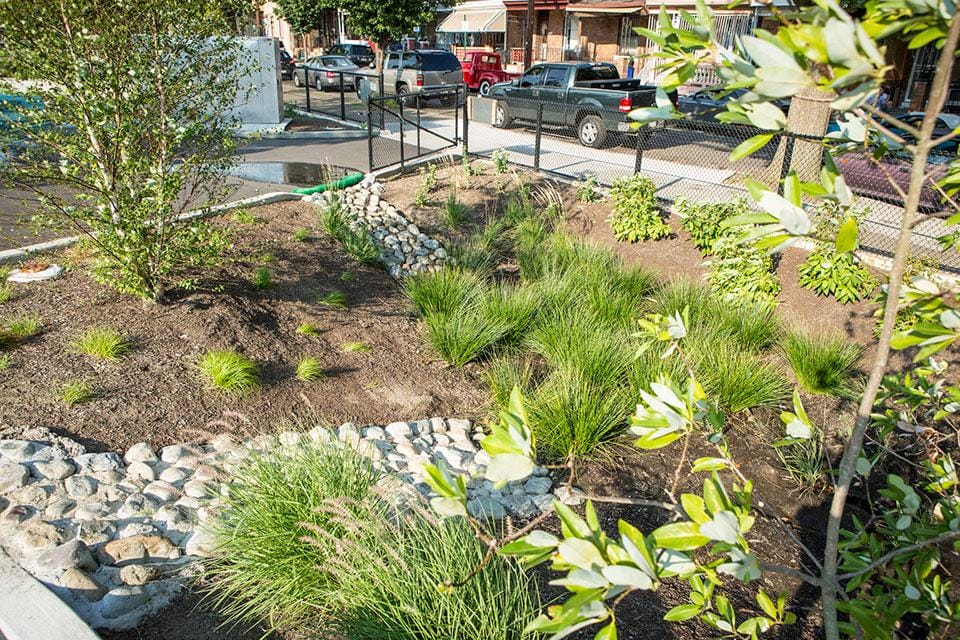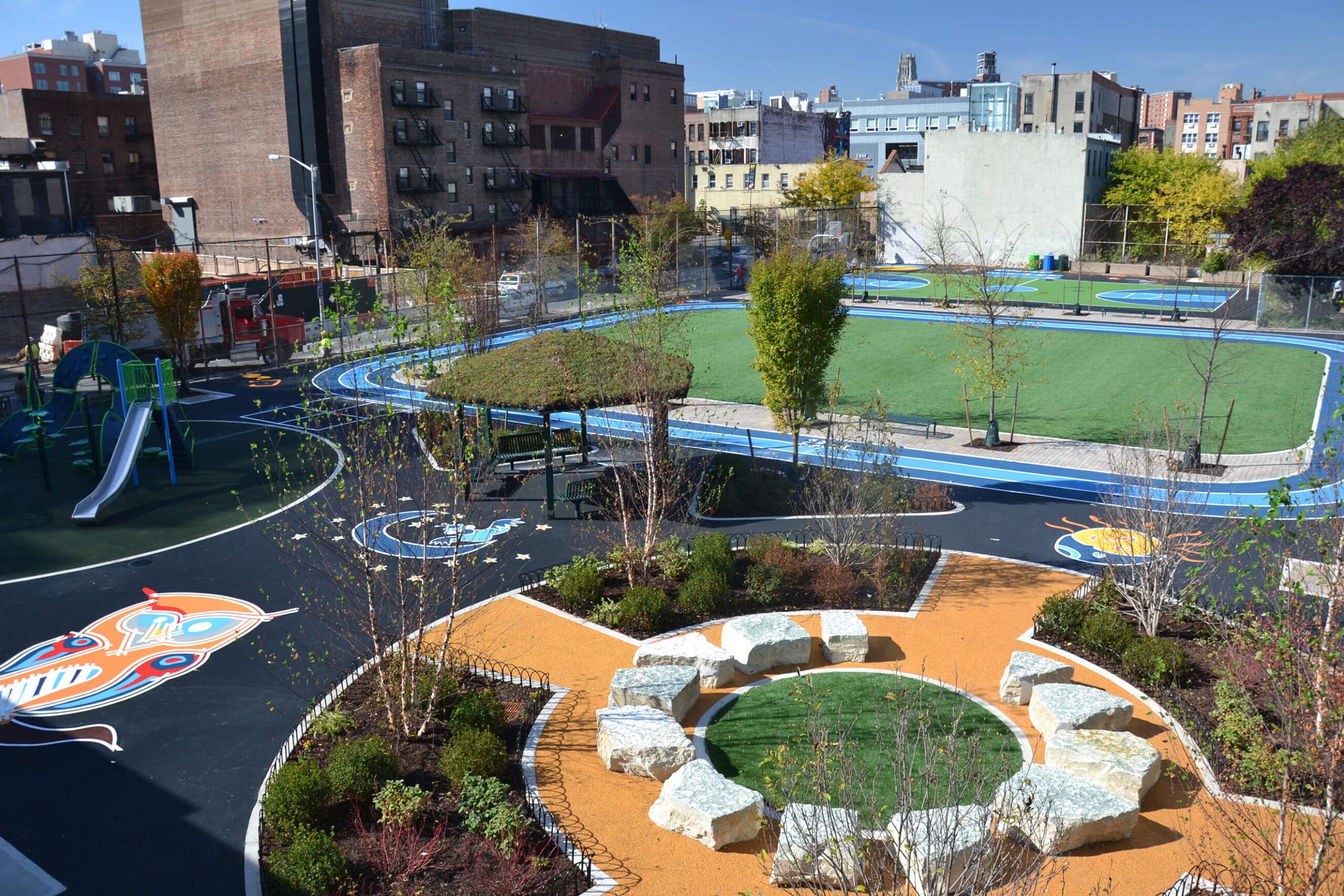For years, the playground at the Harriet Tubman Learning Center in Harlem was more ground than play, just a couple of climber sets stranded on a square of old, cracked asphalt. In 2016, one fourth-grade student scoffed about the playground’s poor state to the New York Amsterdam News. “I think it’s absurd,” the student said. “It’s really bad.”
By 2022, the same playground looked totally different. Early that summer, the school hosted a visit by Dr. Alondra Nelson, a top science and technology policy advisor to President Biden. Nelson went for a look around with White House colleagues and staff from New York City’s Department of Environmental Protection (DEP) and the Mayor’s Office of Climate and Environmental Justice, or MOCEJ.
The White House team saw how this public school property has become part of citywide efforts to protect New Yorkers against the effects of climate change, namely the kind of torrential rainstorms that have hit the city in recent years, which cause flooding and badly pollute streams and rivers. As for that new look, the former asphalt flat has been lit up with color. A 2017 renovation by Trust for Public Land with the DEP gave the Tubman Center (also known as C.S. 154) a vibrant green playing field, track lanes in vivid blues, and a little plaza with permeable paving laid in cantaloupe orange around a ring of huge sitting rocks. It has a small pavilion with a green roof, garden beds thick with shrubs, and, overhead, young shade trees filling out against the hot sun.
Less visible, though, is how the playground became what is essentially a giant sponge. The renovation by TPL and the DEP turned it into a water utility in camouflage, a piece of green infrastructure that serves as a sink for 700,000 gallons of stormwater a year. Joan Keener, the deputy director of TPL’s NYC Playgrounds program, says schoolyards that are renovated to include green infrastructure “manage water on site much better than asphalt.” The sites are reshaped strategically on the surface to “pour [rain] into the trees, the gardens, or the turf field,” Keener says. “Rainfall also filters into the ground, where some projects store it in barrels or buried cisterns for use in irrigation.”
Previously, those 700,000 gallons of stormwater would become runoff to the nearest sewer drain and join toxic flows of septic water normally piped to a treatment plant. Heavy rainstorms overload those combined sewers and send the whole mess gushing into the city’s waterways, where it kills aquatic life and makes those waters untouchable to everyone. Now, at the Tubman Center, the stormwater remains where it falls, and some of it is used to irrigate the plantings on the grounds.
“These projects show kids how their schoolyards are part of the solution of these bigger city efforts to capture stormwater.”
– Tiffany Briery, TPL NYC Playgrounds program manager
The Tubman Center renovation is among 50 climate-adaptation projects TPL and the DEP have completed since 2013 to build green infrastructure on public school grounds in New York City. These green schoolyards serve multiple needs at once: They become kid-worthy places to play. They cut water pollution and prevent nearby flooding. And they create cooler spaces amid urban heat, with heat-deflecting surfaces and shade trees.

A view of the playground at the Harriet Tubman Learning Center before renovation. Photo: TPL staff
The schoolyards also become community parks: known as Community Schoolyards® projects, they stay open to neighbors after school hours and on weekends, giving people who would otherwise lack park space access within a 10-minute walk. In the case of the Harriet Tubman Learning Center, 48 percent of households in that radius have low incomes, and 56 percent identify as Black—both characteristically underserved groups when it comes to green space.
“We always want to evolve and look at how we can make these spaces better,” says Mary Alice Lee, director of TPL’s NYC Playgrounds program and interim New York state director, “and also look at ways we can educate communities and kids about the environment, climate change, and sustainability.” As the White House visitors learned, the stacked benefits of green infrastructure around schools also play into environmental education. Lee shares a telling anecdote about a student thinking they’d made an error tending a schoolyard garden upon discovering green strawberries, not realizing that’s how young fruits begin.
At TPL, Tiffany Briery creates stewardship, community, and educational activities as program manager for the NYC Playgrounds program. Students learn about the green infrastructure retrofitted at their own schools, and they also study maps of similar projects in other neighborhoods, says Briery, “to show the kids how their schoolyards are part of the solution of these bigger city efforts to capture stormwater.” An environmentally alert generation of students is in the works—another enduring benefit, as nature lovers know, because curiosity and learning become the path to caring and stewardship.
Bradford McKee has written about architecture, landscape, and the public realm since 1993. From 2010 to 2020, he was editor in chief of Landscape Architecture Magazine. He lives in Washington, DC, where he serves on the board of Rock Creek Conservancy.
One-third of Americans, including 28 million children, lack safe, easy access to a park within a 10-minute walk of home. Urge your senators to allocate funding to create parks and enhance outdoor recreational opportunities by championing the Outdoors for All Act today!

Green infrastructure refers to features that are designed to assuage the effects of severe storms, such as flooding and water pollution, by mimicking nature. Such features include:
- Absorptive turf fields
- Green roofs and rain gardens
- Underground cisterns
- Shade trees and native plantings

Donate to become a member, and you’ll receive a subscription to Land&People magazine, our biannual publication featuring exclusive, inspiring stories about our work connecting everyone to the outdoors.

